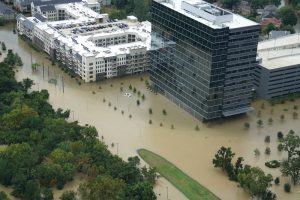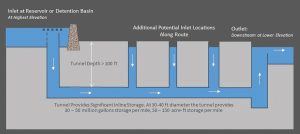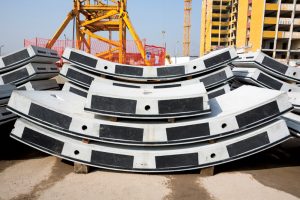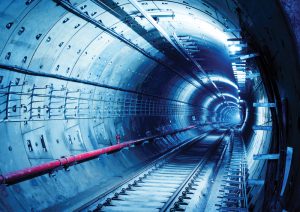Tunneling Opens the Door to 21st-Century Infrastructure Development
The twentieth century saw great monuments to structural engineering erected across the United States, from the Empire State Building to the Golden Gate Bridge and from the Hoover Dam to the Sears Tower. These skyscraping and massive steel-and-concrete structures each challenged preconceived notions of what was possible and left a legacy of engineering and architectural excellence.
In the twenty-first century, urban areas continue to grow rapidly. Some of the fastest expansion is in Texas, where the Kinder Institute at Rice University projects that the population of the state’s urban centers may double by 2040. Four of the largest urban areas – Austin, San Antonio, Dallas, and Houston – already have accounted for 85% of Texas’ overall population growth since 2010. Unrelenting growth in these regions stresses the existing infrastructure, particularly linear civil infrastructure: transportation, water, sewer, and stormwater assets. Surging population presents a two-pronged challenge for city planners – they face more demand coupled with shrinking space for construction. Meanwhile, greenfield sites are gobbled up for development, and existing transportation corridors and utility easements are already full.
In response to this breakneck growth, Texas’ major urban areas are building different kinds of engineering marvels. Instead of skyscrapers reaching toward the sky, they are digging deep underground to install new infrastructure. In the same way that the 102-story Empire State Building challenged engineers in the 1930s, this move underground presents its own set of challenges, particularly in Houston, with its unique geotechnical conditions.
Houston, We Have a Problem
Before August 2017, Houston might have been best-known for the National Aeronautics and Space Administration’s landing a man on the moon, or hosting the largest livestock exhibition and rodeo in the world. After August 25, 2017, the city also became an exhibit for urban flooding in the devastating aftermath of Hurricane Harvey. Massive, persistent rains fell on the sprawling urban and suburban landscape, with its flat terrain and clayey and minimally absorbent soils, triggering devastation never before seen in the city (Figure 1). Up to 60 inches of rain fell during Harvey, leading to widespread flooding resulting in $125 billion in damages and 65 deaths across the Houston region and Southeast Texas.

Figure 1. Flooding caused by Hurricane Harvey’s massive, persistent rain resulted in $125 billion in damages and 65 deaths across the Houston region and Southeast Texas in 2017. Courtesy of ThinkStock.
Following Hurricane Harvey, Houston’s engineering community got to work brainstorming solutions to mitigate the impacts of future flooding events, but few traditional solutions seemed feasible. These traditional solutions for flood mitigation included building regional and local detention basins and widening flood conveyance channels, creeks, and bayous so that additional flow could be conveyed downstream to Galveston Bay. Houston’s urban growth, particularly along the waterways, quickly showed that this approach would require extensive property acquisition – an unpopular, time-consuming, and expensive proposition.
What if, instead of moving stormwater at the surface, it could be conveyed underground, which would take it through densely populated urban areas with minimal community and environmental impacts? That is precisely what the Harris County Flood Control District (HCFCD) wanted to find out in a study beginning in the summer of 2019. HCFCD, the United States Army Corps of Engineers’ non-federal local sponsor for the region, is responsible for approximately 2,500 miles of bayous and tributaries that drain stormwater from Harris County. HCFCD’s service area encompasses Houston and some of Texas’ fastest-growing suburbs. Tunneling has not been a tool in the agency’s arsenals; so, HCFCD leveraged a grant from the United States Economic Development Administration and local funding from voter-approved bonds to start the process of studying the feasibility of tunneling for stormwater management (Figure 2).

Figure 2. Tunneling facilitates construction of an inverted siphon to move large volumes of stormwater safely underground.
Tunneling for stormwater management is not a new idea; the concept has been proven in Chicago, Washington, D.C., and even in Texas cities such as San Antonio, Austin, and Dallas, which all have or are constructing large-diameter, inverted-siphon stormwater tunnels. However, clayey and sandy soils, high groundwater, and creeping growth faults had dissuaded consideration of tunnels in Houston – until now.
Geotechnical Meets Structural Engineering
Tunneling is a nexus between geotechnical and structural engineering. For a project to be safely and successfully constructed, existing earth and groundwater pressures must be balanced by the excavation equipment, and the permanent shafts and tunnel lining systems must support earth and hydrostatic loading over their design lives.
Tunneling in rock, as is common in Dallas, Chicago, and the Upper Midwest, often can rely on the excavated rock formation to be self-supporting with minimal initial support systems. Excavation in competent limestone often can be opened and left without a permanent support system with no geotechnical consequence. In Houston, the clays, sands, and high groundwater require ground support systems to be installed before excavation or immediately after excavation. These are much different and more complex systems.
Excavation equipment must use pressurized-face tunneling equipment to control the earth and groundwater pressure that continually acts on the tunnel boring machine, and also varies along the tunnel alignment as different geologic formations are encountered. Earth pressure balance and slurry tunnel boring machines are both pressurized-face tunneling equipment that could be used in Houston depending on the soil and groundwater conditions that are encountered.
Immediately following excavation, the pressurized-face tunnel boring machine erects precast concrete segments for both the initial and permanent excavation support system for the tunnel. The precast concrete segments are typically produced at a manufacturing facility, cured, and then transported to the project site for erection. The segments can also be fabricated on or near the site. Factory production of precast segments results in higher repeatability and quality across large batches than cast-in-place concrete structures, which can be challenging in large and deep tunnels.

Figure 3. Structural design of concrete segments used for tunnels continues to improve, making the segments more durable and corrosion-resistant. Courtesy of Cylonphoto/123rf.com.
In most tunnel applications, the concrete segments (Figure 3) form a concentric compression ring as they counteract the earth and groundwater pressure deep underground. In unique circumstances, if the tunnel’s internal pressure due to the conveyed water, wastewater, or stormwater is expected to exceed the confining earth and groundwater pressure, post-tensioning may be required in the segments. This is to ensure that the segments remain in compression.
Traditional concrete segment structural designs incorporated steel reinforcement. As in other concrete structures, this reinforcement is the leading cause of deterioration. As the steel corrodes, the rust increases the volume of the steel, creating tensile cracks that can result in spalling, cracking, and other failures. Concrete segment designs are now using alternatives to steel reinforcement, including steel wire mesh and, more recently, steel fiber and synthetic fiber reinforcement to prolong concrete service life, particularly in corrosive environments.
Steel fibers are noncontinuous and discrete, so there is less potential for propagation of corrosion activity. Also, because the fibers are evenly distributed throughout the entire volume of the segment and are present closer to the surface of the concrete than steel reinforcement, the segments are more durable, reducing the risk of damage to the edges and corners due to handling. Steel fiber reinforcement improves the overall quality and reduces the need for rework. Synthetic fibers offer similar benefits as steel fibers plus even greater corrosion protection because they are innately corrosion resistant.
Bekaert Maccaferri, a manufacturer of steel fiber for segments, indicates that impact resistance of steel fiber-reinforced segments is 20 times higher than for unreinforced concrete. Impact resistance is a benefit of both steel and synthetic fiber-reinforced concrete. Recent laboratory testing of synthetic fiber-reinforced concrete found that strain during impact loading was reduced by as much as 68 percent compared to unreinforced concrete.
The first tunnel solely using synthetic fiber-reinforced segments is currently under construction near Kansas City, Missouri. These advances in segment reinforcement technology provide greater durability, longer service life, and an improved final product at a comparable or lower cost than the traditional methods.
Crossing a Different Kind of Fault
Improvements in tunneling technology over the last 30 years have mitigated many risks associated with tunneling in soft ground with high groundwater tables. But the greatest geotechnical and structural challenge facing tunneling in Houston may be crossing active growth faults that are slowly but continuously creeping toward the Gulf of Mexico. The most-active faults generally cross west and northwest Houston in a northeasterly direction, including the Long Point and Brittmoore Faults, which have been measured to creep up to one-half inch per year. Although they are not at risk of rupture or generating seismic events, the consistent creeping of these faults poses a challenge to any concrete structures crossing them, as evidenced by the frequent concrete pavement patches required on Houston’s Interstate 10 above the surface expression of the Long Point Fault.
Special structural design considerations must be made for these fault crossings to ensure that the tunnel can withstand the potential fault displacement over its service life. Prospective mitigation concepts are being evaluated as part of the study commissioned by HCFCD and will be developed in greater detail in the future.
Skyscrapers of the Underground

Figure 4. Tunnels are the skyscrapers of the underground, facilitating needed higher-density infrastructure development in urban areas and presenting unique engineering challenges the same way the first skyscrapers did in the 20th century. Courtesy of Gui Yongnian/123rf.com.
Houston’s unique geology, urbanization, and extreme weather events are encouraging innovative thinking about infrastructure. Tunneling, once considered impractical, is now at the forefront of the effort to build resiliency into one of America’s largest urban areas (Figure 4). This effort, still in the early planning phases, will require innovative engineering and construction solutions to serve as a backbone for the next century of infrastructure investments.■
